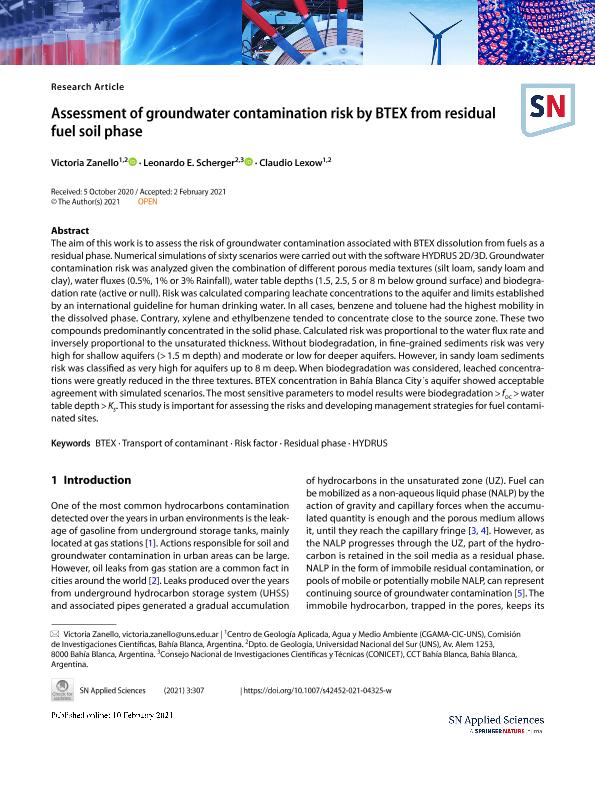Mostrar el registro sencillo del ítem
dc.contributor.author
Zanello, Victoria

dc.contributor.author
Scherger, Leonardo Ezequiel

dc.contributor.author
Lexow, Claudio

dc.date.available
2022-01-05T17:04:36Z
dc.date.issued
2021-03
dc.identifier.citation
Zanello, Victoria; Scherger, Leonardo Ezequiel; Lexow, Claudio; Assessment of groundwater contamination risk by BTEX from residual fuel soil phase; Springer; SN Applied Sciences; 3; 3; 3-2021; 1-20
dc.identifier.issn
2523-3963
dc.identifier.uri
http://hdl.handle.net/11336/149654
dc.description.abstract
The aim of this work is to assess the risk of groundwater contamination associated with BTEX dissolution from fuels as a residual phase. Numerical simulations of sixty scenarios were carried out with the software HYDRUS 2D/3D. Groundwater contamination risk was analyzed given the combination of different porous media textures (silt loam, sandy loam and clay), water fluxes (0.5%, 1% or 3% Rainfall), water table depths (1.5, 2.5, 5 or 8 m below ground surface) and biodegradation rate (active or null). Risk was calculated comparing leachate concentrations to the aquifer and limits established by an international guideline for human drinking water. In all cases, benzene and toluene had the highest mobility in the dissolved phase. Contrary, xylene and ethylbenzene tended to concentrate close to the source zone. These two compounds predominantly concentrated in the solid phase. Calculated risk was proportional to the water flux rate and inversely proportional to the unsaturated thickness. Without biodegradation, in fine-grained sediments risk was very high for shallow aquifers (> 1.5 m depth) and moderate or low for deeper aquifers. However, in sandy loam sediments risk was classified as very high for aquifers up to 8 m deep. When biodegradation was considered, leached concentrations were greatly reduced in the three textures. BTEX concentration in Bahía Blanca City´s aquifer showed acceptable agreement with simulated scenarios. The most sensitive parameters to model results were biodegradation > foc > water table depth > Ks. This study is important for assessing the risks and developing management strategies for fuel contaminated sites.
dc.format
application/pdf
dc.language.iso
eng
dc.publisher
Springer

dc.rights
info:eu-repo/semantics/openAccess
dc.rights.uri
https://creativecommons.org/licenses/by/2.5/ar/
dc.subject
BTEX
dc.subject
HYDRUS
dc.subject
RESIDUAL PHASE
dc.subject
RISK FACTOR
dc.subject
TRANSPORT OF CONTAMINANT
dc.subject.classification
Oceanografía, Hidrología, Recursos Hídricos

dc.subject.classification
Ciencias de la Tierra y relacionadas con el Medio Ambiente

dc.subject.classification
CIENCIAS NATURALES Y EXACTAS

dc.title
Assessment of groundwater contamination risk by BTEX from residual fuel soil phase
dc.type
info:eu-repo/semantics/article
dc.type
info:ar-repo/semantics/artículo
dc.type
info:eu-repo/semantics/publishedVersion
dc.date.updated
2021-07-27T15:00:24Z
dc.identifier.eissn
2523-3971
dc.journal.volume
3
dc.journal.number
3
dc.journal.pagination
1-20
dc.journal.pais
Alemania

dc.journal.ciudad
Berlín
dc.description.fil
Fil: Zanello, Victoria. Consejo Nacional de Investigaciones Científicas y Técnicas. Centro Científico Tecnológico Conicet - Bahía Blanca; Argentina. Universidad Nacional del Sur. Departamento de Geología; Argentina. Comisión de Investigaciones Científicas de la Provincia de Buenos Aires. Centro de Geología Aplicada, Agua y Medio Ambiente; Argentina
dc.description.fil
Fil: Scherger, Leonardo Ezequiel. Consejo Nacional de Investigaciones Científicas y Técnicas. Centro Científico Tecnológico Conicet - Bahía Blanca; Argentina. Universidad Nacional del Sur. Departamento de Geología; Argentina
dc.description.fil
Fil: Lexow, Claudio. Consejo Nacional de Investigaciones Científicas y Técnicas. Centro Científico Tecnológico Conicet - Bahía Blanca; Argentina. Universidad Nacional del Sur. Departamento de Geología; Argentina. Comisión de Investigaciones Científicas de la Provincia de Buenos Aires. Centro de Geología Aplicada, Agua y Medio Ambiente; Argentina
dc.journal.title
SN Applied Sciences
dc.relation.alternativeid
info:eu-repo/semantics/altIdentifier/url/http://link.springer.com/10.1007/s42452-021-04325-w
dc.relation.alternativeid
info:eu-repo/semantics/altIdentifier/doi/http://dx.doi.org/10.1007/s42452-021-04325-w
Archivos asociados
